engine ASTON MARTIN V8 VANTAGE 2010 Workshop Manual
[x] Cancel search | Manufacturer: ASTON MARTIN, Model Year: 2010, Model line: V8 VANTAGE, Model: ASTON MARTIN V8 VANTAGE 2010Pages: 947, PDF Size: 43.21 MB
Page 419 of 947
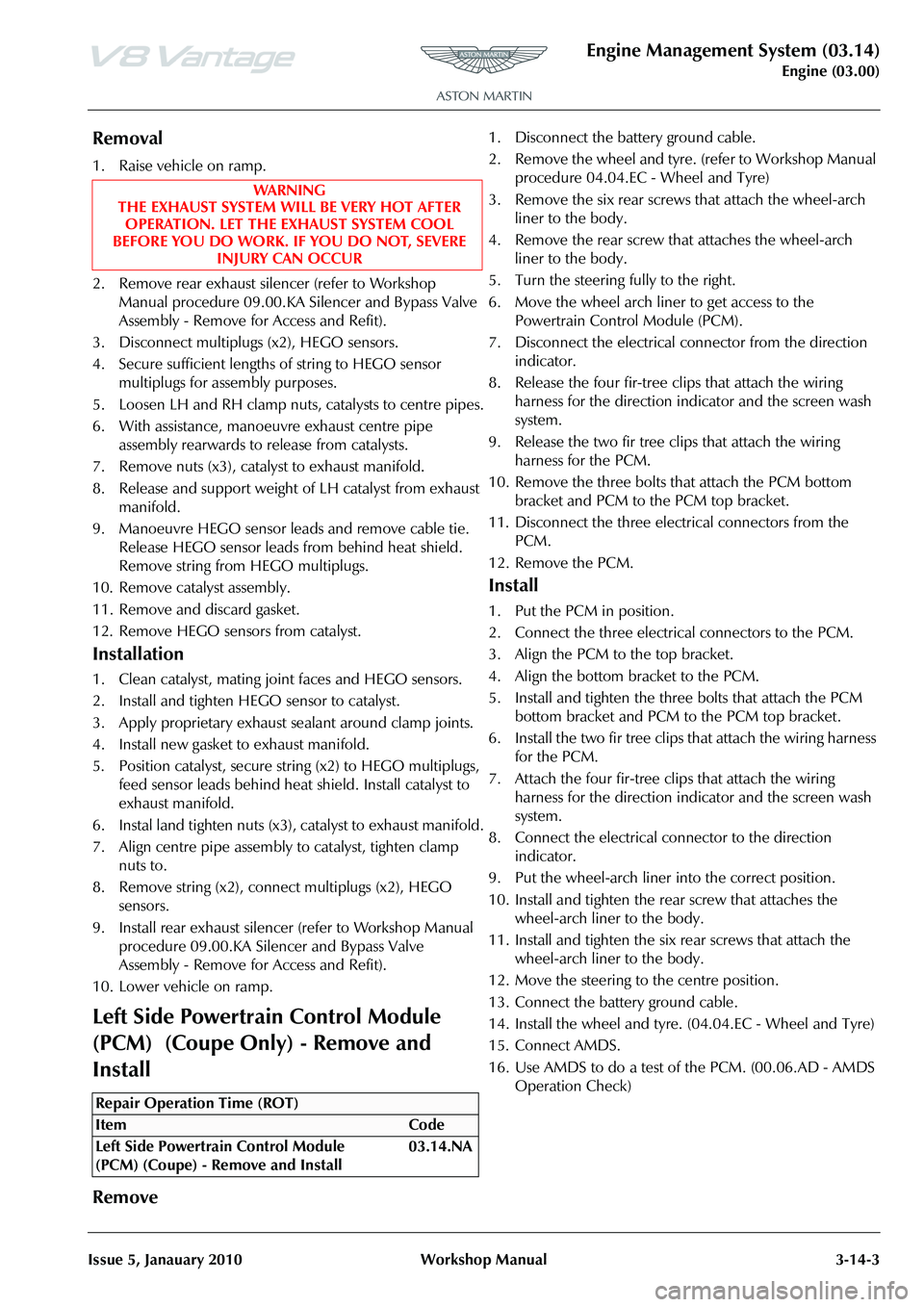
Engine Management System (03.14)
Engine (03.00)
Issue 5, Janauary 2010 Workshop Manual 3-14-3
Removal
1. Raise vehicle on ramp.
2. Remove rear exhaust silencer (refer to Workshop Manual procedure 09.00.KA Silencer and Bypass Valve
Assembly - Remove for Access and Refit).
3. Disconnect multiplugs (x2), HEGO sensors.
4. Secure sufficient lengths of string to HEGO sensor multiplugs for assembly purposes.
5. Loosen LH and RH clamp nuts, catalysts to centre pipes.
6. With assistance, manoeuvre exhaust centre pipe assembly rearwards to release from catalysts.
7. Remove nuts (x3), catalyst to exhaust manifold.
8. Release and support weight of LH catalyst from exhaust manifold.
9. Manoeuvre HEGO sensor leads and remove cable tie. Release HEGO sensor leads from behind heat shield.
Remove string from HEGO multiplugs.
10. Remove catalyst assembly.
11. Remove and discard gasket.
12. Remove HEGO sensors from catalyst.
Installation
1. Clean catalyst, mating joint faces and HEGO sensors.
2. Install and tighten HEGO sensor to catalyst.
3. Apply proprietary exhaust se alant around clamp joints.
4. Install new gasket to exhaust manifold.
5. Position catalyst, secure string (x2) to HEGO multiplugs, feed sensor leads behind heat shield. Install catalyst to
exhaust manifold.
6. Instal land tighten nuts (x3), catalyst to exhaust manifold.
7. Align centre pipe assembly to catalyst, tighten clamp
nuts to.
8. Remove string (x2), conne ct multiplugs (x2), HEGO
sensors.
9. Install rear exhaust silencer (refer to Workshop Manual procedure 09.00.KA Silencer and Bypass Valve
Assembly - Remove for Access and Refit).
10. Lower vehicle on ramp.
Left Side Powertrain Control Module
(PCM) (Coupe Only) - Remove and
Install
Remove
1. Disconnect the ba ttery ground cable.
2. Remove the wheel and tyre. (refer to Workshop Manual procedure 04.04.EC - Wheel and Tyre)
3. Remove the six rear screws that attach the wheel-arch liner to the body.
4. Remove the rear screw that attaches the wheel-arch liner to the body.
5. Turn the steering fully to the right.
6. Move the wheel arch liner to get access to the Powertrain Control Module (PCM).
7. Disconnect the electrical connector from the direction
indicator.
8. Release the four fi r-tree clips that attach the wiring
harness for the direction indi cator and the screen wash
system.
9. Release the two fir tree clips that attach the wiring harness for the PCM.
10. Remove the three bolts that attach the PCM bottom bracket and PCM to the PCM top bracket.
11. Disconnect the three electrical connectors from the PCM.
12. Remove the PCM.
Install
1. Put the PCM in position.
2. Connect the three electrical connectors to the PCM.
3. Align the PCM to the top bracket.
4. Align the bottom bracket to the PCM.
5. Install and tighten the three bolts that attach the PCM bottom bracket and PCM to the PCM top bracket.
6. Install the two fir tree clips that attach the wiring harness for the PCM.
7. Attach the four fir-tree cl ips that attach the wiring
harness for the direction indi cator and the screen wash
system.
8. Connect the electrical connector to the direction indicator.
9. Put the wheel-arch liner into the correct position.
10. Install and tighten the rear screw that attaches the wheel-arch liner to the body.
11. Install and tighten the six rear screws that attach the wheel-arch liner to the body.
12. Move the steering to the centre position.
13. Connect the battery ground cable.
14. Install the wheel and tyre. (04.04.EC - Wheel and Tyre)
15. Connect AMDS.
16. Use AMDS to do a test of the PCM. (00.06.AD - AMDS Operation Check)
WA R N I N G
THE EXHAUST SYSTEM WILL BE VERY HOT AFTER OPERATION. LET THE EXHAUST SYSTEM COOL
BEFORE YOU DO WORK. IF YOU DO NOT, SEVERE
INJURY CAN OCCUR
Repair Operation Time (ROT)
Page 420 of 947

Engine Management System (03.14)
Engine (03.00)3-14-4 Workshop Manual Issue 5, Janauary 2010
Left Side Powertrain Control Module
(PCM) (Roadster Only) - Remove and
Install
Remove
1. Disconnect the battery ground cable.
2. Lift the vehicle on a four-post lift.
3. Remove the centre undertray. (refer to Workshop Manual procedure 01.02.MB - Centre Undertray)
4. Lower the vehicle.
5. Lift the vehicle on a two-post lift.
6. Remove the wheel and tyre. (refer to Workshop Manual procedure 04.04.EC - Wheel and Tyre)
7. Remove the six rear screws that attach the wheel-arch liner to the body.
8. Remove the rear screw that attaches the wheel-arch liner to the body.
9. Turn the steering fully to the right.
10. Move the wheel-arch liner to get access to the Powertrain Control Module (PCM).
11. Disconnect the electrical connector from the direction indicator.
12. Release the four fir tree cl ips that attach the wiring
harness for the direction indicator and the screen wash
system.
13. Release the two fir tree clips that attach the wiring harness for the PCM.
14. Remove the three screws that attach the PCM bottom bracket and PCM to the PCM top bracket.
15. Disconnect the three elec trical connectors from the
PCM.
16. Remove the PCM.
Install
1. Put the PCM in position.
2. Connect the three electrical connectors to the PCM.
3. Align the PCM with the top bracket.
4. Align the bottom bracket with the PCM.
5. Install and tighten the three screws that attach the PCM bottom bracket and PCM to the PCM top bracket.
6. Install the two fir tree clips that attach the wiring harness for the PCM.
7. Attach the four fir tree clips that attach the wiring harness for the indicator and the screen wash system.
8. Connect the electrical connector to the indicator.
9. Put the wheel-arch liner into the correct position.
10. Install and tighten the rear screw that attaches the wheel-arch liner to the body. 11. Install and tighten the six rear screws that attach the
wheel-arch liner to the body.
12. Install the centre undertray. (refer to Workshop Manual procedure 01.02.MB - Centre Undertray)
13. Install the wheel and tyre. (refer to Workshop Manual procedure 04.04.EC - Wheel and Tyre)
14. Move the steering to the centre position.
15. Connect the battery ground cable.
Repair Operation Time (ROT)
Page 421 of 947

Throttle Control (03.16)
Engine (03.00)
May 2007 Workshop Manual 3-15-1
Engine (03.00)
Throttle Control (03.16)
Description
Motorised Throttles
The motorised throttle allows accurate control
of the inlet air.
A throttle position sensor (TPS) is incorporated
into the throttle unit. During normal engine
run, TPS signals are used by the PCM to
indicate power demand from the engine. If not
already at the desired position, the PCM will
drive the throttle motor to open or close the
throttle by the required amount.
At idle, the throttle butterfly is almost closed
and idle speed is controlled by small throttle
movements.
The throttle butterfly is spring loaded to fail in
the idle position. In the event of the throttle
butterfly spring failing, air flow will allow the
throttle butterflies to fail in the idle position.
No set-up procedure is required.
Page 422 of 947
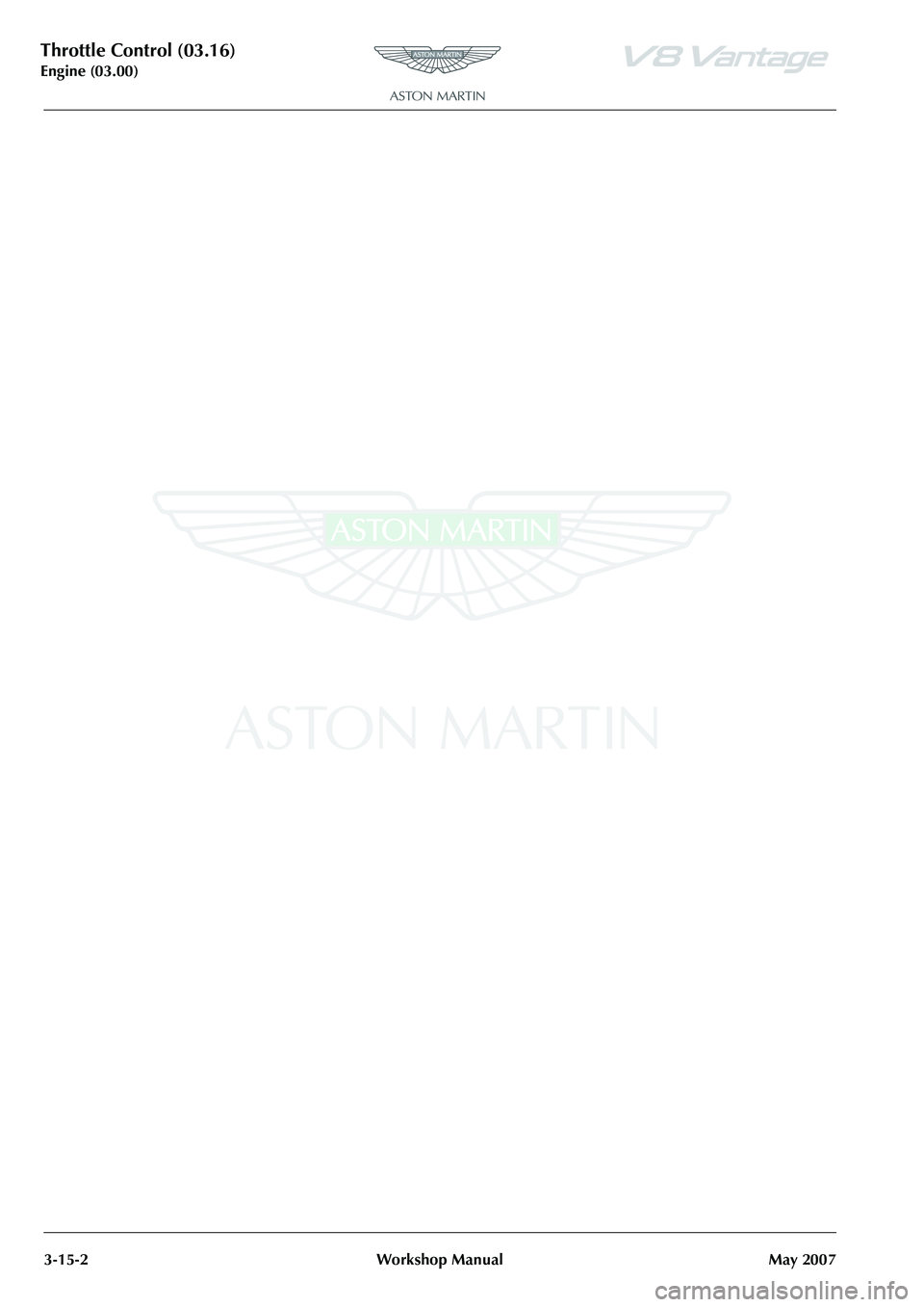
Throttle Control (03.16)
Engine (03.00)3-15-2 Workshop Manual May 2007
Page 423 of 947
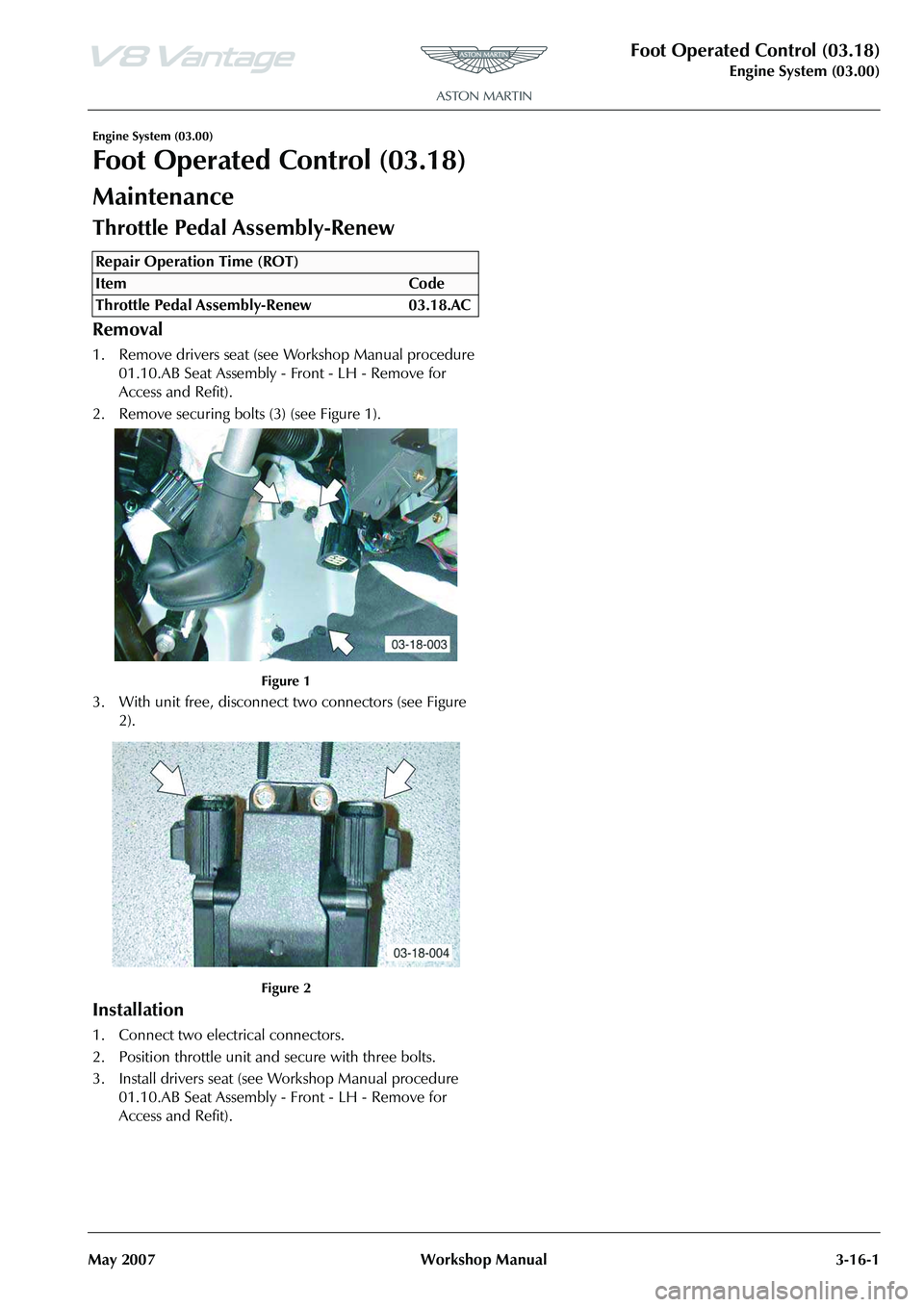
Foot Operated Control (03.18)
Engine System (03.00)
May 2007 Workshop Manual 3-16-1
Engine System (03.00)
Foot Operated Control (03.18)
Maintenance
Throttle Pedal Assembly-Renew
Removal
1. Remove drivers seat (see Workshop Manual procedure
01.10.AB Seat Assembly - Front - LH - Remove for
Access and Refit).
2. Remove securing bolts (3) (see Figure 1).
Figure 1
3. With unit free, disconnect two connectors (see Figure
2).
Figure 2
Installation
1. Connect two electrical connectors.
2. Position throttle unit and secure with three bolts.
3. Install drivers seat (see Workshop Manual procedure 01.10.AB Seat Assembly - Front - LH - Remove for
Access and Refit).
Repair Operation Time (ROT)
Page 424 of 947
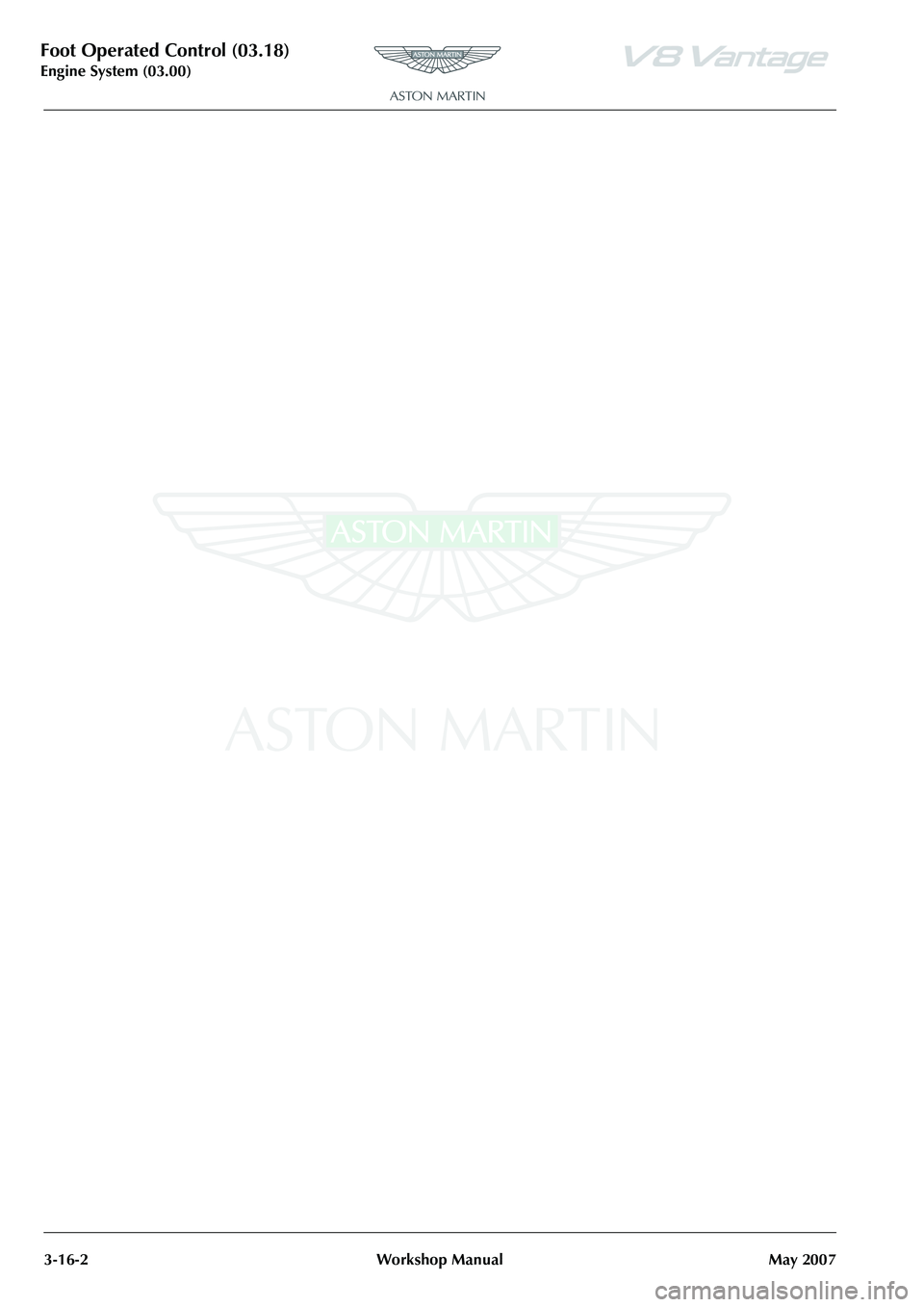
Foot Operated Control (03.18)
Engine System (03.00)3-16-2 Workshop Manual May 2007
Page 430 of 947

Front Suspension (04.01)
Suspension (04.00)4-1-4 Workshop Manual November 2008
RH/LH Lower Front Suspension Arm
Assembly - Renew
Removal
1. Raise vehicle on ramp.
2. Remove road wheel(s).
3. Remove nut/washer securing anti-roll bar link to lower suspension, release link from arm.
4. Remove nut/bolt securing damper to lower suspension arm, release damper from mounting.
5. Remove nut securing lower suspension arm ball-joint to vertical link.
6. Install tool (204 - 523) ba ll-joint remover and release
lower suspension ball-joi nt from vertical link.
7. Mark fitted positions of cam washers on lower suspension arm inner fixings to aid assembly purpose.
8. Remove nuts/bolts, cam washers (x2), securing lower suspension arm to subframe.
9. Release/remove lower suspension arm from subframe and vertical link.
Installation
1. Clean lower suspension arm and mating faces on vertical link and subframe
2. Install lower suspension arm in subframe.
3. Install cam washers, bolts/nuts (x2). Align cam washers to marks. Do not torque tighten at this stage.
4. Install lower suspension arm ball-joint in vertical link. Install and torque tighten nut.
5. Align damper to mounting, install bolt/nut. Do not torque tighten at this stage.
6. Install anti-roll bar link, install washer/nut. Do not torque tighten at this stage.
7. Final tightening of suspen sion components must be
carried out with the suspensi on arms at normal ride
height.
8. Install road wheel(s).
9. Lower vehicle on ramp.
10. Torque tighten suspension nuts/bolts.
11. 4 wheel alignment - check/adjust (see Workshop Manual procedure 04.00.AD 4 Wheel Alignment -
Check and Adjust).
RH/LH Upper Front Suspension Arm
Assembly - Renew
Removal
1. Raise the vehicle and make it safe.
2. Remove the road wheel for the applicable suspension arm.
3. Disconnect the electrical connector from the ABS sensor.
4. Release the three sensor harness clips from the upper suspension arm and the vertical link.
5. Remove the two Torx screws that attach the engine cross brace to the mounting.
6. Remove the two nuts and two bolts that attach the upper suspension arm to the body.
7. Release the suspension arm from the body.
8. Remove the three nuts that attach the damper top mounting.
9. Remove the mounting for the engine cross brace.
10. Remove the nut and bolt that attaches the damper to its lower mounting.
11. Remove spring/damper assembly.
12. Remove the nut that attaches the ball-joint for the upper suspension arm to the vertical link.
13. Install tool (204 - 523 - ball-joint remover) and release the ball-joint from vertical link.
14. Remove the upper suspension arm assembly.
Installation
1. Clean the upper suspension arm and the mating faces on the body and the vertical link.
2. Install the upper suspension arm to vertical link. Install the nut but do not torque tighten at this step.
3. Install spring/damper assembly.
4. Install the cross-brace support.
5. Install the three nuts but do not torque tighten at this step.
6. Align the damper to the lower mounting, install bolt/nut. Do not torque tighten at this step.
7. Put the upper suspension arm in positionon the body.
8. Install bolts and nuts but do not torque tighten at this step.
9. Connect the electrical connector to the ABS sensor.
Repair Operation Time (ROT)Repair Operation Time (ROT)
ItemCode
Upper Front Suspension Arm
Assembly-Renew RH
04.01.AE
Upper Front Suspension Arm
Assembly-Renew LH
04.01.AF
Caution
Be carefulthat you do not damage the ball-joint rubber
boot when you use the special tool.
Page 431 of 947

Front Suspension (04.01)
Suspension (04.00)
November 2008 Workshop Manual 4-1-5
10. Install the three sensor harness clips in the upper suspension and the vertical link.
11. Install the road wheel.
12. Lower the vehicle on ramp.
13. Do an all-wheel alignment procedure (Refer to ’All
Wheel Alignment’, page 4-0-2).
14. Torque tighten suspension nuts and bolts.
15. Align engine cross brace to support, install and torque tighten Torx bolts (x2).
Front Anti-Roll Bar - Renew
Removal
1. Raise vehicle on ramp.
2. Remove road wheel(s).
3. Remove front undertray (see Workshop Manual procedure 01.02.NB Undertray - Front - Renew).
4. Remove nuts and washers (x2), anti-roll bar to drop links.
5. Remove bolts (x4), straps (x2).
6. Remove anti-roll bar.
7. Remove bushes (x2) from anti-roll bar.
Installation
1. Clean anti-roll bar, bushes and straps.
2. Install bushes (x2) on anti-roll bar.
3. Position anti-roll bar, align bushes (x2), install straps (x2), install bolts (x4). Do not torque tighten.
4. Install drop links to anti-roll bar, install nuts/washers (x2).
Do not torque tighten.
5. Install front undertray (see Workshop Manual procedure 01.02.NB Undertray - Front - Renew).
6. Lower vehicle in ramp.
7. Torque tighten link nuts (x4).
8. Torque tighten bush strap bolts (x4).
Front Pair Anti-Roll Bar Bushing - Renew
Removal
1. Raise vehicle on ramp.
2. Remove front undertray (see Workshop Manual procedure 01.02.NB Undertray - Front - Renew).
3. Remove bolts (x4) securing anti-roll bar bush straps to subframe.
4. Release/remove bush straps.
5. Remove bushes (x2) from anti-roll bar.
Installation
1. Clean anti-roll bar and bush straps.
2. Install bushes on to anti-roll bar.
3. Install bush straps (x2), install bolts (x4). Do not torque tighten at this stage.
4. Install front undertray (see Workshop Manual procedure 01.02.NB Undertray - Front - Renew).
5. Lower vehicle on ramp.
6. Torque tighten all suspension nuts/bolts.
RH/LH Front Anti-Roll Bar Link - Renew
Removal
1. Raise vehicle on ramp.
2. Remove road wheel(s).
3. Remove nut/bolt securing damper to lower suspension
arm.
4. Release damper from mounting sufficient to remove top anti-roll bar link.
5. Remove nuts and washers (x2) , link to lower suspension
arm and anti-roll bar.
6. Release and remove anti-roll bar link.
Installation
1. Clean anti-roll bar link and mating faces on lower suspension arm and anti-roll bar.
2. Install link to anti-roll bar and lower suspension arm.
3. Install washers (x2) and nuts (x2). Do not torque tighten.
Caution
Do not fully tighten the nuts and bolts on the suspension
components. Only tighten the nuts and bolts of the
suspension components when the suspension arms are
at their usual ride-height and you have adjusted the
geometry. If you do not do this, the suspension bushes
will have too much stress when the suspension is moved
to its maximum upward travel.
Repair Operation Time (ROT)
Repair Operation Time (ROT)
Repair Operation Time (ROT)
Page 441 of 947
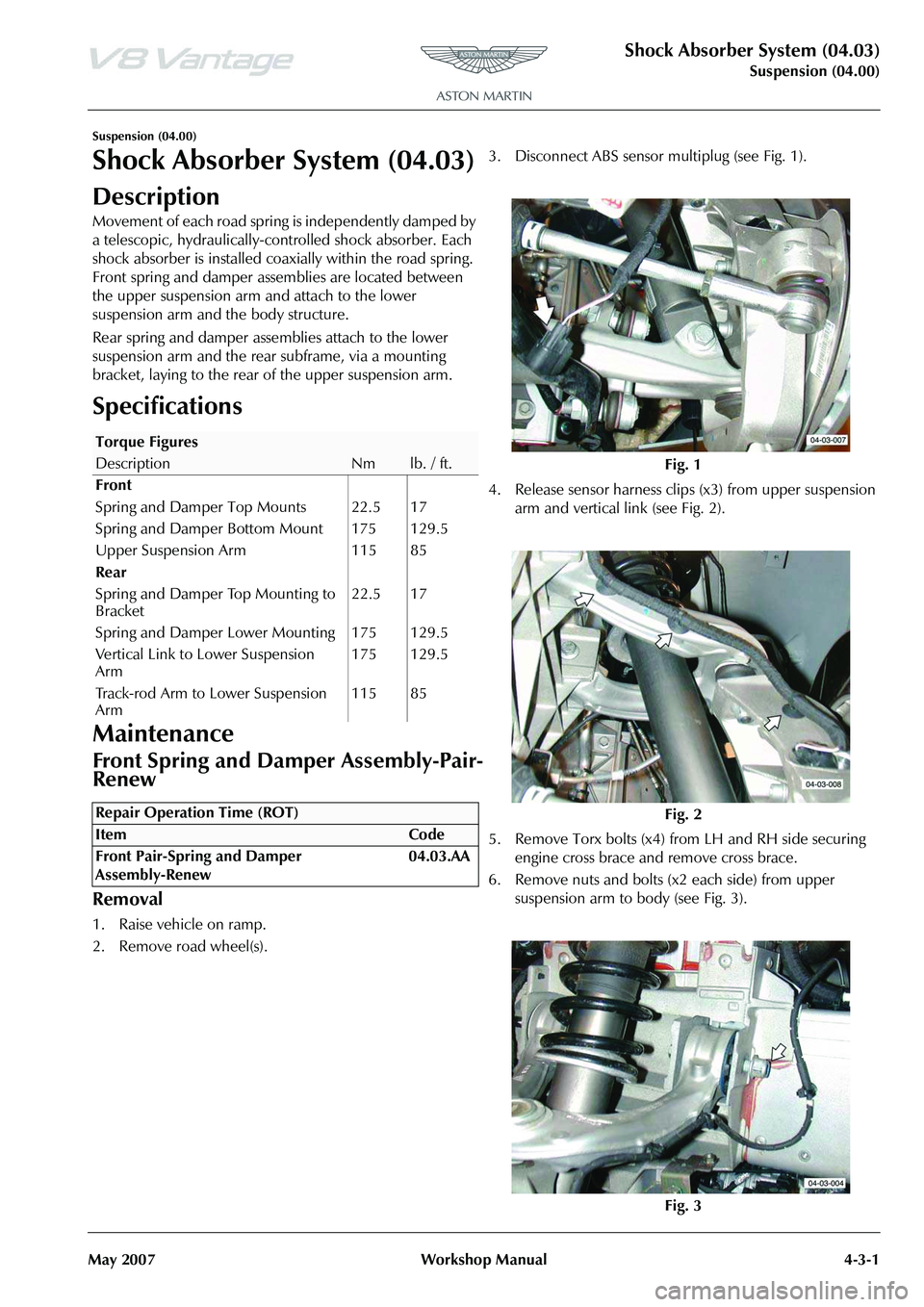
Shock Absorber System (04.03)
Suspension (04.00)
May 2007 Workshop Manual 4-3-1
Suspension (04.00)
Shock Absorber System (04.03)
Description
Movement of each road spring is independently damped by
a telescopic, hydraulically-controlled shock absorber. Each
shock absorber is installed coax ially within the road spring.
Front spring and damper assemblies are located between
the upper suspension arm and attach to the lower
suspension arm and the body structure.
Rear spring and damper assemblies attach to the lower
suspension arm and the rear subframe, via a mounting
bracket, laying to the rear of the upper suspension arm.
Specifications
Maintenance
Front Spring and Damper Assembly-Pair-
Renew
Removal
1. Raise vehicle on ramp.
2. Remove road wheel(s). 3. Disconnect ABS sensor
multiplug (see Fig. 1).
4. Release sensor harness clips (x3) from upper suspension arm and vertical li nk (see Fig. 2).
5. Remove Torx bolts (x4) fr om LH and RH side securing
engine cross brace and remove cross brace.
6. Remove nuts and bolts (x2 each side) from upper suspension arm to body (see Fig. 3).
Torque Figures
DescriptionNmlb. / ft.
Front
Spring and Damper Top Mounts 22.5 17
Spring and Damper Bottom Mount 175 129.5
Upper Suspension Arm 115 85
Rear
Spring and Damper Top Mounting to
Bracket 22.5 17
Spring and Damper Lower Mounting 175 129.5
Vertical Link to Lower Suspension
Arm 175 129.5
Track-rod Arm to Lower Suspension
Arm 115 85
Repair Operation Time (ROT)
Fig. 1
Fig. 2
Fig. 3
Page 442 of 947

Shock Absorber System (04.03)
Suspension (04.00)4-3-2 Workshop Manual May 2007
7. Position suspension arm aside (see Fig. 4).
8. Remove nuts (x3 each side) from damper top mounting. and remove engine cross br ace support (see Fig. 5). 9. Remove nuts and bolts each side from damper lower
mountings (see Fig, 6).
10. Remove spring and damper assembly.
Installation
1. Install spring and damper assembly and engine cross brace support.
2. Install top mounting nuts (x3) each side (do not torque tighten).
3. Align damper to lower mounting and install bolts and nuts each side (do not torque tighten).
4. Position upper suspension arm to body and install bolts and nuts (x2) each side (do not torque tighten).
5. Connect ABS sensor multiplug and install harness clips in upper suspension ar m and vertical link.
6. Install road wheel(s).
7. Lower vehicle on ramp.
8. Tighten upper arm nuts and bolts.
9. Torque tighten top mounting nuts (x3) and lower mounting nut and bolt.
10. Install engine cross brace and install and torque tighten
Torx bolts (x4).
Allow the upper suspension ar
m and vertical link to fall
back, giving access to remo ve the spring and damper
assembly.
Caution
Make sure that the brake flex hose is not over stretched.
Fig. 4
Fig. 5
If removing both spring and damper units - the engine bay
cross brace will be released.
Fig. 6
If removed, place the engine ba y cross brace, complete with
mounts, in position.
Caution
Ensure that the brake flex hose is not over stretched.
Caution
Final tightening of suspen sion components must be
carried out with the suspension arms at normal ride
height. Failure to do this wi ll over stress the suspension
bushes when the suspension is deflected to maximum
upward travel.